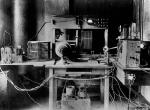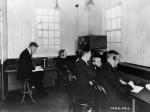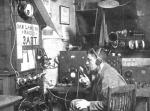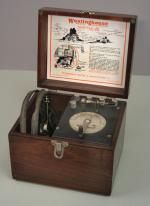![header=[Marker Text] body=[At his garage workshop here in 1919-1920, Conrad made broadcasts over his amateur station, 8XK, which introduced the concept of commercial radio and led to the start of KDKA. For 37 years a Westinghouse engineer, he held over 200 patents.] sign](http://explorepahistory.com/kora/files/1/10/1-A-3A4-139-ExplorePAHistory-a0m4t3-a_450.jpg)
Mouse over for marker text
Name:
Frank Conrad
Region:
Pittsburgh Region
County:
Allegheny
Marker Location:
Pa. 8 (Penn Ave.) & Peebles St., W end Wilkinsburg
Dedication Date:
December 1, 1990
Behind the Marker
Frank Conrad did not invent modern radio. He was not the first to use vacuum tubes in his radio apparatus. Nor was he the first to send voice and music "into the ether" in the early 1900s. Conrad was, however, the right man, in the right place, at the right time. His Pittsburgh-based amateur radio station changed how corporate patent owners thought about radio and led the way in radio's momentous transition from a method of point-to-point communication to a national network of broadcasters that transmitted to millions of eager listeners and consumers.
The son of a railroad mechanic, Conrad was bored by formal schooling at Pittsburgh's Starrett Grammar. So in 1890, at the age of sixteen, he left school to become an apprentice bench hand in the new research shops of the Westinghouse Electric and Manufacturing Company at Garrison Alley. Inside, Westinghouse engineers were doing groundbreaking work on alternating current (AC) motors, transmission devices, and other electrical components.
Westinghouse Electric and Manufacturing Company at Garrison Alley. Inside, Westinghouse engineers were doing groundbreaking work on alternating current (AC) motors, transmission devices, and other electrical components.
Once established in the Testing Department, Conrad became one of the company's most productive inventors. He designed a disk-type watt-hour meter used in homes throughout the United States, then perfected an electrical system for automobiles. To win a $5 bet about the accuracy of his $12 watch, he in 1912 built a hypersensitive radio receiver to monitor U.S. Naval Observatory Time. Four years later he received a license from the Department of Commerce's Bureau of Navigation to "broadcast" Morse code under the call letter 8XK from his garage workshop in Wilkinsburg.
During World War I, Westinghouse increased it involvement in the development of radiotelegraphy, designing radiotelephone transmitters and receivers for the U.S. Signal Corp and the Navy. After the federal government suspended nearly all amateur radio licenses to avoid interference with essential messages and to limit the possible use of radio by enemy spies, Conrad continued to work on radio as a hobby in his garage, using new vacuum tubes developed by Westinghouse. After the war ended, Westinghouse made a significant investment in radio patents and licenses so that it could compete with General Electric in international radio transmission. At the same time, Conrad made a fascinating, and what soon turned out to be groundbreaking discovery through after-hour ham radiotelephony broadcasts from his garage.
Anxious to try out the latest technology, Conrad resumed his ham radio broadcasts in 1919, using a new microphone and a continuous wave transmitter that enabled him to broadcast voices when most others were still employing spark telegraphy. As his broadcasts grew in popularity, Conrad began to expand his broadcasts, including Saturday night live performances by family members, coworkers and local professional musicians, and with phonograph recordings. Soon Pittsburghers contacted Conrad "requesting" that he play songs at particular times. Conrad then made an arrangement with the Hamilton Music Store: free records in exchange for mentions of the store. Soon, Pittsburgh's Joseph Horne Department Store was running newspaper ads boasting that their wireless sets were capable of receiving Conrad's broadcasts.
Conrad's broadcasts were uncovering a vast market of people eager for news and entertainment. This activity soon came to the attention of Westinghouse vice president Harry P. Davis, who was quick to recognize the commercial potential. For local goodwill, and to sell the radio receivers that Westinghouse had begun to manufacture, Davis asked Conrad to build a station at its East Pittsburgh plant and to have it running by November 2, to broadcast the returns in the presidential election between Warren G. Harding and James Cox.
On October 27, Westinghouse received a broadcast license from the federal Commerce Department to broadcast as a commercial shore station under the call letters KDKA. At 6 p.m. on November 2, KDKA hummed to life, broadcasting at 100 watts. As the election returns arrived at the Pittsburgh Post, a reporter telephoned them to Westinghouse, where publicist Leo Rosenberg read the latest updates while a banjo player strummed between.
KDKA hummed to life, broadcasting at 100 watts. As the election returns arrived at the Pittsburgh Post, a reporter telephoned them to Westinghouse, where publicist Leo Rosenberg read the latest updates while a banjo player strummed between.
Few people actually heard them, but KDKA's election-returns broadcast drew national attention. In the years that followed, radio broadcasting became a booming industry and the radio a household fixture. And therein lay the significance of Frank Conrad's pioneering work in radio broadcasting. Through his work with 8XK and KDKA, Conrad played an important role in the birth of the American radio broadcasting system by demonstrating the money to be made, with only a modest investment of capital, by broadcasting, and the mass market for radio receivers, the manufacture of which quickly became a major consumer industry. Davis's hunch also paid quick dividends for Westinghouse, through the sale of Westinghouse's Aeriola Jr. Radio sets.
drew national attention. In the years that followed, radio broadcasting became a booming industry and the radio a household fixture. And therein lay the significance of Frank Conrad's pioneering work in radio broadcasting. Through his work with 8XK and KDKA, Conrad played an important role in the birth of the American radio broadcasting system by demonstrating the money to be made, with only a modest investment of capital, by broadcasting, and the mass market for radio receivers, the manufacture of which quickly became a major consumer industry. Davis's hunch also paid quick dividends for Westinghouse, through the sale of Westinghouse's Aeriola Jr. Radio sets.
After his success in developing Westinghouse's first radio station, KDKA, Conrad moved to Westinghouse's Forest Hills research facility, where he worked on the development of long-distance radio communication. By the time he retired from Westinghouse in 1940, Conrad had accrued more than 200 patents. He received an honorary degree from the University of Pittsburgh in 1928, and in 1930 he received the American Institute of Electrical Engineers' Edison Medal "for his contributions to radio broadcasting and shortwave radio transmission."
long-distance radio communication. By the time he retired from Westinghouse in 1940, Conrad had accrued more than 200 patents. He received an honorary degree from the University of Pittsburgh in 1928, and in 1930 he received the American Institute of Electrical Engineers' Edison Medal "for his contributions to radio broadcasting and shortwave radio transmission."
Frank Conrad died in Miami, Fla., on December 10, 1941.
The son of a railroad mechanic, Conrad was bored by formal schooling at Pittsburgh's Starrett Grammar. So in 1890, at the age of sixteen, he left school to become an apprentice bench hand in the new research shops of the
Once established in the Testing Department, Conrad became one of the company's most productive inventors. He designed a disk-type watt-hour meter used in homes throughout the United States, then perfected an electrical system for automobiles. To win a $5 bet about the accuracy of his $12 watch, he in 1912 built a hypersensitive radio receiver to monitor U.S. Naval Observatory Time. Four years later he received a license from the Department of Commerce's Bureau of Navigation to "broadcast" Morse code under the call letter 8XK from his garage workshop in Wilkinsburg.
During World War I, Westinghouse increased it involvement in the development of radiotelegraphy, designing radiotelephone transmitters and receivers for the U.S. Signal Corp and the Navy. After the federal government suspended nearly all amateur radio licenses to avoid interference with essential messages and to limit the possible use of radio by enemy spies, Conrad continued to work on radio as a hobby in his garage, using new vacuum tubes developed by Westinghouse. After the war ended, Westinghouse made a significant investment in radio patents and licenses so that it could compete with General Electric in international radio transmission. At the same time, Conrad made a fascinating, and what soon turned out to be groundbreaking discovery through after-hour ham radiotelephony broadcasts from his garage.
Anxious to try out the latest technology, Conrad resumed his ham radio broadcasts in 1919, using a new microphone and a continuous wave transmitter that enabled him to broadcast voices when most others were still employing spark telegraphy. As his broadcasts grew in popularity, Conrad began to expand his broadcasts, including Saturday night live performances by family members, coworkers and local professional musicians, and with phonograph recordings. Soon Pittsburghers contacted Conrad "requesting" that he play songs at particular times. Conrad then made an arrangement with the Hamilton Music Store: free records in exchange for mentions of the store. Soon, Pittsburgh's Joseph Horne Department Store was running newspaper ads boasting that their wireless sets were capable of receiving Conrad's broadcasts.
Conrad's broadcasts were uncovering a vast market of people eager for news and entertainment. This activity soon came to the attention of Westinghouse vice president Harry P. Davis, who was quick to recognize the commercial potential. For local goodwill, and to sell the radio receivers that Westinghouse had begun to manufacture, Davis asked Conrad to build a station at its East Pittsburgh plant and to have it running by November 2, to broadcast the returns in the presidential election between Warren G. Harding and James Cox.
On October 27, Westinghouse received a broadcast license from the federal Commerce Department to broadcast as a commercial shore station under the call letters KDKA. At 6 p.m. on November 2,
Few people actually heard them, but KDKA's election-returns broadcast
After his success in developing Westinghouse's first radio station, KDKA, Conrad moved to Westinghouse's Forest Hills research facility, where he worked on the development of
Frank Conrad died in Miami, Fla., on December 10, 1941.
Beyond the Marker










